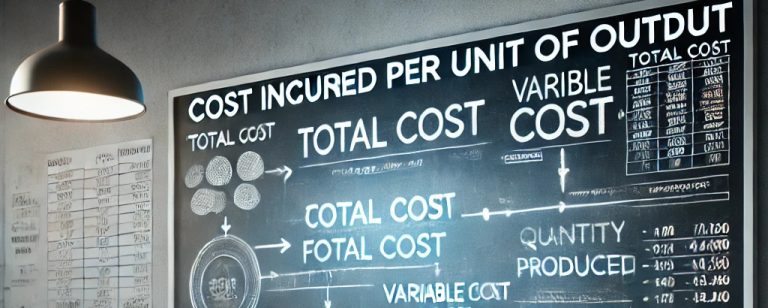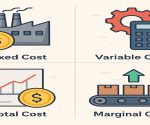Cost Incurred Per Unit of Output is a key concept in cost accounting and economics. It refers to the total cost a company incurs to produce a single unit of output. This cost is crucial for pricing strategies, profit margin analysis, and assessing operational efficiency. Understanding how to calculate and manage the cost incurred per unit of output allows businesses to make informed decisions about pricing, resource allocation, and overall profitability. In this article, we will delve into the various components of unit cost, calculation methods, and how it affects business operations.
What is Cost Incurred Per Unit of Output?
Cost Incurred Per Unit of Output is the amount of money spent to produce each unit of a good or service. It includes both fixed and variable costs, distributed over the number of units produced. By calculating the cost per unit, companies can assess their profitability, set competitive prices, and make strategic decisions to optimize operations. The key to accurate cost management is knowing how to break down total costs into per-unit terms, ensuring that each item produced is contributing to the company’s financial goals.
Components of Cost Incurred Per Unit of Output
The cost incurred per unit of output comprises both fixed and variable costs. To calculate this, businesses must first understand the distinction between the two:
1. Fixed Costs
Fixed costs are costs that do not change regardless of the level of production. These costs must be incurred even if no production takes place. Examples include:
- Rent for factory space
- Salaries of permanent employees
- Depreciation of equipment
2. Variable Costs
Variable costs, on the other hand, change directly with the level of output. The more products a company makes, the higher the variable costs will be. Examples include:
- Raw materials used in production
- Labor costs tied to the production process (e.g., hourly wages)
- Utility bills (electricity, water, etc., tied to production)
Formula to Calculate Total Cost per Unit
Understanding these components is essential in calculating the cost per unit accurately. By separating fixed and variable costs, companies can more easily track and control their expenses.
How to Calculate Cost Incurred Per Unit of Output?
Step-by-Step Calculation
To calculate the cost incurred per unit of output, follow these steps:
- Calculate Total Fixed Costs: Identify all fixed costs that do not change regardless of production levels. For example, rent, salaries, and insurance premiums.
- Calculate Total Variable Costs: Sum up all costs that vary with production, such as raw materials, hourly wages, and utility costs.
- Determine Total Output: Calculate the total number of units produced during the period under analysis.
- Apply the Formula: Divide the sum of fixed and variable costs by the total output produced to obtain the cost per unit of output.
Example
Suppose a company produces 1,000 units of a product, with total fixed costs of $5,000 and total variable costs of $3,000. The cost incurred per unit of output would be calculated as follows:
Thus, the cost incurred per unit of output is $8.
Why is This Important?
The cost incurred per unit of output is essential for:
- Pricing: Setting the right price for a product by ensuring it covers both fixed and variable costs.
- Profitability: Calculating how much profit the company makes after covering all costs.
- Budgeting: Forecasting future production costs and profitability.
Understanding the cost per unit is essential for businesses looking to scale efficiently while maintaining profitability.
Types of Costs Included in the Cost Per Unit of Output
When calculating cost incurred per unit of output, it is important to account for various types of costs that contribute to the final figure. These include:
1. Direct Costs
Direct costs are expenses that can be directly attributed to the production of a specific product. These costs include:
- Direct Labor: Wages paid to workers directly involved in the production process.
- Direct Materials: Raw materials used in the manufacture of products.
2. Indirect Costs
Indirect costs, or overheads, are expenses that are not directly tied to the production of a particular good or service but are necessary for business operations. These include:
- Rent for the production facility
- Administrative salaries
- Utilities such as electricity, heating, and water, which are used in the production process
3. Semi-Variable Costs
As mentioned earlier, semi-variable costs are costs that have both fixed and variable components. For example, a phone bill that has a fixed monthly charge plus additional charges based on usage would fall under this category.
4. Opportunity Costs
Although not always factored directly into the cost per unit of output, opportunity costs should be considered when making production decisions. Opportunity cost refers to the value of the best alternative foregone when a choice is made.
By categorizing costs in this way, businesses can better understand their overall cost structure and make informed decisions about pricing, production volume, and cost control strategies.
Impact of Economies of Scale on Cost Per Unit of Output
Economies of scale refer to the cost advantages that companies experience as they increase production. As production volume increases, the cost incurred per unit of output typically decreases due to the spread of fixed costs over a larger number of units and improved efficiencies in variable costs.
Key Effects of Economies of Scale
- Reduction in Fixed Costs per Unit: As output increases, the fixed cost per unit decreases.
- Lower Variable Costs per Unit: Bulk purchasing of materials and optimized production processes can reduce the variable cost per unit.
- Increased Production Efficiency: As companies grow, they often improve production methods and technology, which leads to more efficient use of labor and materials.
Example
A company that produces 1,000 units of a product may have fixed costs of $5,000 and variable costs of $3,000, giving it a cost per unit of $8. However, if production increases to 10,000 units, the fixed costs remain the same, but the per-unit fixed cost decreases. This results in a lower overall cost incurred per unit of output.
Conclusion
Understanding the cost incurred per unit of output is critical for effective business management. This cost structure, composed of fixed, variable, and indirect costs, helps businesses price their products, make cost-effective production decisions, and assess profitability. By monitoring and managing costs per unit, companies can improve their operational efficiency, remain competitive in the marketplace, and increase overall profitability. Analyzing cost per unit also aids in identifying areas where cost savings can be achieved, ensuring a more sustainable and financially sound business.
Cost Incurred Per Unit of Output FAQs
What is the cost incurred per unit of output?
The cost incurred per unit of output refers to the total cost a business incurs to produce a single unit of a product. It includes fixed costs, variable costs, and sometimes semi-variable costs, divided by the total number of units produced.
How do you calculate the cost per unit?
The cost per unit is calculated by adding fixed costs and variable costs, then dividing the total by the number of units produced. The formula is:
What are fixed and variable costs?
Fixed costs are expenses that remain the same regardless of production levels, such as rent and salaries. Variable costs fluctuate with production volume, such as raw materials and hourly wages.
What is the role of economies of scale in reducing the cost per unit?
As production increases, fixed costs are spread over more units, leading to a reduction in the fixed cost per unit. Variable costs also decrease due to efficiencies in the production process, resulting in a lower overall cost incurred per unit of output.
Why is calculating the cost per unit important for businesses?
Calculating the cost incurred per unit of output helps businesses set prices, assess profitability, manage costs effectively, and make informed decisions about scaling production and resource allocation.


